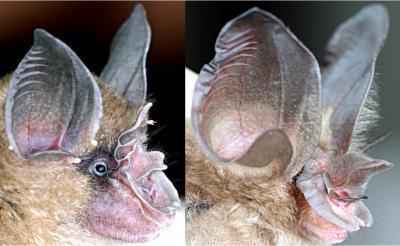A recent study conducted by members of the University of Virginia technology department explained the secret that existed for 60 years about the oversized big nose of a rare bat species.
The article with the title 'Sound effect accurately predicts a typical case of biological morphology' of Z. Zhang, R. Müller, and SN Truong describes in detail the big eared bat called Bourret's horseshoe. bat (fan leaf bat) or Rhinolophus paradoxolophus according to scientific nomenclature, with a nose nearly 9 mm long. According to Rolf Mueller, the nose of horseshoe bat (horseshoe) is usually only half the size above. 'This nose is indeed too big for all the remaining bat species in the region, ' he said.
Mueller's findings show that bats use this oversized long nose to create highly focused ultrasound signals. Bats monitor its environment through ultrasound signals emitted by the mouth, or from the nose as a case of paradoxolophus. The echo sound wave gives information about objects in the surrounding environment. Fan leaf bats, bats that live in the dense tropical forests of Southeast Asia have been assigned to this name 58 years ago due to its secret body characteristics .
 Picture of normal horseshoe bat (horseshoe bat) (left) and fan leaf bat (Bourret's horseshoe bat) (right). The computer model shows that the fan leaf's oversized nose is used to create highly focused ultrasound signals. (Photo: Rolf Mueller)
Picture of normal horseshoe bat (horseshoe bat) (left) and fan leaf bat (Bourret's horseshoe bat) (right). The computer model shows that the fan leaf's oversized nose is used to create highly focused ultrasound signals. (Photo: Rolf Mueller)
Like a flash that can emit small but strong rays, this bat's nose can produce ultrasonic waves with similar properties. Mueller and his team used computers to compare the different sizes of regular bat noses and the researched bats. Mueller thinks that this nose is a perfect evolutionary mark , because the computer model shows that the nose length of this bat has stopped at the right number but if passed, the focus of the ultrasound will become invisible. means.
'By predicting the width of the ultrasound for each size of the nose using a computerized method, we found that the natural length of the nose is of special value: if it is shorter than the design. This natural result will result in fewer ultrasound waves, and longer nose making will only bring insignificant benefits, ' Mueller said. 'Therefore, this extraordinary form of biological shape can only be explained by physical function.'
Fan leaf results are part of a larger study of 120 different bat species and how they use ultrasound to identify their surroundings. Ending in February 2010 according to the program, scientists hope that the focus of research on sound communication and perception in bat will lay the foundation for improvements in mobile phone technology. dynamic and satellite communication, as well as marine surveillance technology.
Mueller began research with engineers and scientists from Shandong, China University and the Vietnam Academy of Sciences. The article will appear in Physical Review Letters' July 17 hard copy and on July 14th online page.
 Animal 'suffering' after hibernation
Animal 'suffering' after hibernation Why do goats climb well?
Why do goats climb well? Scientists were surprised to see chimpanzees eating turtles
Scientists were surprised to see chimpanzees eating turtles Giant catfish died deadly due to drought in Thailand
Giant catfish died deadly due to drought in Thailand